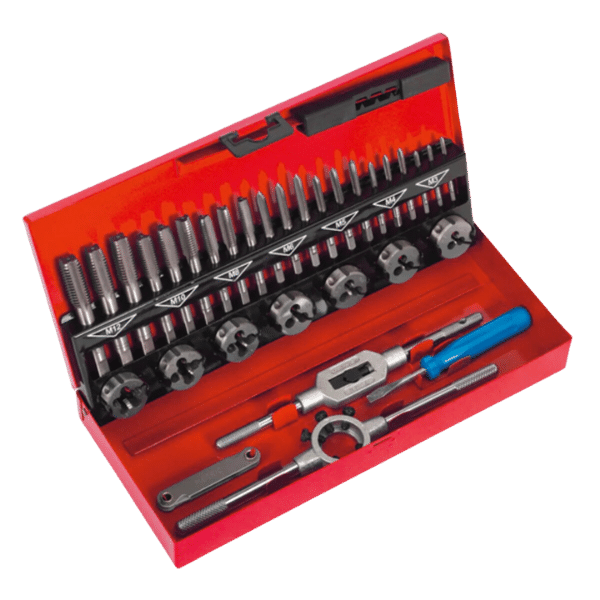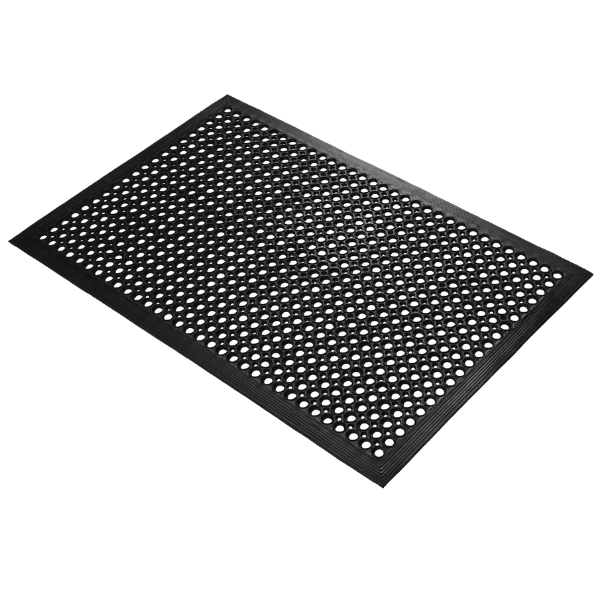Toolboxes and Tool Chests
More information about Toolboxes and Tool Chests
Equip with Excellence: Toolboxes & Chests for Crafted Precision
Organising your workspace, nothing beats the efficiency of our robust Toolboxes and Tool Chests. Designed to cater to the diverse needs of businesses, our range of metal tool chests and workshop toolboxes offer the perfect blend of durability, functionality, and style. Whether you're a small business owner or run a large-scale operation, our tool storage options are a perfect fit for your requirements.
Our metal tool chests are built to withstand the rigours of daily use, offering a sturdy and reliable storage solution for your tools. With various sizes and configurations available, you can find the perfect chest to suit your needs. Similarly, our workshop toolboxes are designed with practicality in mind, providing easy access to your tools while keeping them safe and secure.
Explore our extensive range of Toolboxes and Tool Chests today and discover how we can help streamline your business operations. With our high-quality products, you can ensure that your workspace is always organised, efficient, and ready for any task at hand.
Understanding Toolboxes and Tool Chests
Toolboxes and Tool Chests are robust storage solutions that house small tools, parts, and accessories. They are a favourite among mechanics, technicians, and DIY enthusiasts. These containers are typically made from durable materials, such as metal or hard-wearing plastic, and feature various storage options like drawers, pockets, and loops. They are often lockable and portable, equipped with either a carry handle or wheels for easy transportation.
Benefits of Using Toolboxes and Tool Chests
Toolboxes and Tool Chests offer numerous advantages. They provide a secure, organised space for storing valuable tools, protecting them from harmful elements like chemicals, oils, and harsh weather conditions. They also reduce the time spent searching for the right tool and minimise the risk of misplacing essential tools or parts. Lockable toolboxes and chests deter theft, vandalism, and misuse by unauthorised personnel. Plus, their portability helps prevent manual handling injuries associated with moving tools. Lastly, they project a professional image, which is particularly beneficial for customer-facing technicians.
Things to Consider
- Size and Capacity: Consider the dimensions and storage capacity of the toolbox or tool chest. It should be able to accommodate all your tools and equipment effectively, ensuring easy access and organisation.
- Material and Durability: Look for toolboxes and tool chests made from high-quality materials such as steel or aluminium. These materials are durable and can withstand heavy use, ensuring longevity and protection for your tools.
- Locking Mechanism: Ensure that the toolbox or tool chest has a secure locking mechanism to prevent unauthorised access and theft. This is particularly important if you work in environments where tools are shared or stored in communal areas.
- Portability: If you frequently need to transport your tools, consider the portability of the toolbox or tool chest. Look for features such as handles, wheels, or a lightweight design that will make it easier to move around.
- Organisation Features: Look for toolboxes or chests that offer various compartments, drawers, or dividers to help you effectively organise your tools. This will save you time and effort by allowing you to locate the required tools when needed easily.
- Accessibility: Consider how easily you can access your tools within the toolbox or tool chest. Look for features such as easy-glide drawers or removable trays that provide convenient access to your tools without the need for extensive searching or rearranging.
- Compatibility: If you have specific tools or equipment that require specialised storage, ensure that the toolbox or tool chest is compatible with the dimensions and requirements of those items. This will prevent any damage or inconvenience caused by inadequate storage options.
- Aesthetics: While not essential, the appearance of the toolbox or tool chest may be important to some individuals. Consider the design, colour, and overall aesthetics to ensure it aligns with your personal preferences or the branding of your workspace.
Frequently Asked Questions
What is the difference between a Toolbox and a Tool Chest
A toolbox and a tool chest are both used for storing and organising tools, but there are some key differences between the two:
1. Size: Toolboxes are typically smaller and more portable, designed to hold fewer tools. They are often used by DIY enthusiasts or for small projects. On the other hand, tool chests are larger and have more storage capacity, making them suitable for professional mechanics or individuals with a large collection of tools.
2. Portability: Toolboxes are designed to be easily carried around, with a handle or a shoulder strap for convenience. They are lightweight and compact, allowing users to transport their tools to different locations. Tool chests, on the other hand, are usually stationary and not meant to be moved frequently. They are often placed in a workshop or garage and used as a permanent storage solution.
3. organisation: Toolboxes usually have a single compartment or a few small compartments to store tools. They may have removable trays or dividers to help organise smaller items. On the other hand, tool chests have multiple drawers or compartments of varying sizes, allowing for better organisation of tools. They often have labelled drawers or foam inserts to keep tools in their designated places.
4. Durability: Toolboxes are generally made of lightweight materials like plastic or metal, which may not be as sturdy as the materials used in tool chests. Tool chests are typically made of heavy-duty steel or aluminium, making them more durable and able to withstand heavy use and rough handling.
5. Cost: Toolboxes are generally more affordable compared to tool chests. They are designed for basic tool storage needs and are suitable for individuals on a budget. Tool chests, on the other hand, are more expensive due to their larger size, better organisation features, and higher durability.
Ultimately, choosing between a toolbox and a tool chest depends on the user's specific needs and preferences.
How do you organise a tool chest?
organising a tool chest can be done in a few simple steps:
1. Empty the tool chest: Start by removing all the tools and accessories from the chest. This will give you a clean slate to work with.
2. Sort and categorise: Group similar tools together based on their type or function. For example, separate screwdrivers, wrenches, pliers, and so on. This will help you identify the different categories of tools you have.
3. Evaluate and declutter: Look at each tool and assess its usefulness. If you have duplicate or broken tools, consider getting rid of them. This will help declutter your tool chest and make space for more essential tools.
4. Determine storage options: Depending on the size and shape of your tools, decide on the best storage options. Some common choices include tool trays, foam inserts, or drawer dividers. You can also use pegboards or magnetic strips to hang certain tools.
5. Arrange tools by frequency of use: Place the tools you use most frequently in easily accessible areas, such as the top drawer or tray. Less frequently used tools can be stored in lower or less accessible areas.
6. Label and mark: To make it easier to find tools, consider labelling or marking the storage spaces. This can be done using tape, stickers, or a label maker. Clearly labelling each section will help you quickly locate the tool you need.
7. Maintain organisation: Once you have organised your tool chest, make it a habit to put tools back in their designated spots after each use. This will help maintain the organisation and prevent clutter from building up.
Remember, the key to organising a tool chest is to create a system that works for you and makes it easy to find and access your tools when needed.
Are Tool Chests Secure?
Tool chests can vary in terms of security depending on the specific model and brand. However, many tool chests are designed to provide a certain level of security for your tools. They often feature sturdy construction, durable locks, and sometimes even additional security measures such as reinforced corners or anti-pry features. It's important to choose a tool chest from a reputable brand and consider factors such as the quality of the lock, thickness of the metal, and overall construction to ensure a higher level of security.
First Mats Choice
-
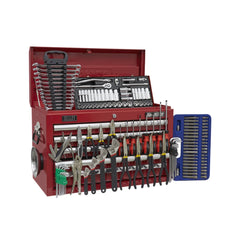 139 Piece Workshop Toolchest and Tool Kit
139 Piece Workshop Toolchest and Tool Kit

["Heavy gauge steel construction","Ball bearing drawer slides","Compact storage solution"]
2 to 4 working days £514.90 Excl. VAT £719.95 Excl. VAT -
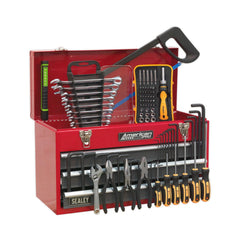 Complete 3 Drawer Metal Tool Chest with 93pc Tool Set
Complete 3 Drawer Metal Tool Chest with 93pc Tool Set

["Includes 93 piece tool set","Lockable with padlock","Available in red/grey or high-vis green"]
2 to 4 working days £165.80 Excl. VAT £229.95 Excl. VAT -
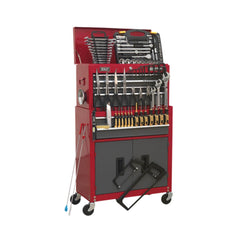 Mobile Toolchest Kits Complete with Tools
Mobile Toolchest Kits Complete with Tools

["Mobile Tool Cabinet","Available in two sizes","Delivery in 3 to 5 days"]
2 to 4 working days £266.00 Excl. VAT £379.95 Excl. VAT








